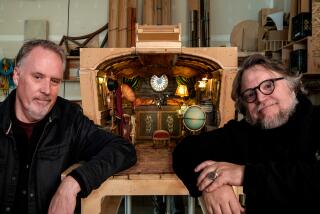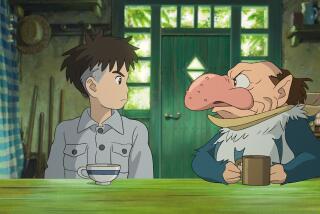Ralph Bakshi Works Still Getting People Animated
Ralph Bakshi is chain-smoking Vantages and eating soup from a plastic foam cup.
âIâve gotten reviews that would make most directors weep,â he says, âand still Iâm finding it a battle.â
He fidgets and curses frequently as he muses about cartoons.
âItâs insane how some people perceive me,â he says. âIâm a very square guy. I really am.â
Bakshiâs dilemma began with his first major success--his 1972 movie âFritz the Catâ got an X rating for its animated journey through Harlem in search of women and pot parties. A few years later, Bakshi populated his âAmerican Popâ with such unlikely cartoon figures as gangsters and beatniks.
There were a half-dozen additional films that brought sex, violence and social commentary into the kingdom of âSleeping Beauty.â Bakshi earned critical acclaim and a revolutionaryâs reputation. He also earned public outrage.
Last season he took his art to television, to something as innocent as Mighty Mouse. And he has stumbled into trouble again.
Earlier this month, two media watchdog groups condemned the CBS series âMighty Mouse: The New Adventuresâ for allegedly portraying drug use. During one episode, they say, there is a 3 1/2-second scene in which the Mouse of Steel does something that looks suspiciously like snorting cocaine.
CBS has vehemently denied the allegations and defended Bakshi.
The cartoonist is mystified by this controversy, but says he probably should have seen it coming. Bakshi paces as he talks. He is a tall man with a large belly. The walls of his Van Nuys office are covered with colorful sketches that flutter in his wake.
âIâm paying for my reputation,â Bakshi says. âHave I enjoyed it? No. I wish life would be easier.â
During an interview, there are only two instances when Bakshiâs nervous pessimism eases. First, when he talks about his family. Second, when he talks about cartoons.
âIâm an artist and Iâm very passionate about the art of animation,â he says. âThatâs the truth.â
Bakshi has his supporters. Critics have been kind. Viacom, an independent distributor, signed Bakshi to a long-term agreement. Action for Childrenâs Television recently honored him for the intelligent scripts and artistic animation in âMighty Mouse.â
âHeâs a breath of fresh air in terms of his audacity and unrestrained humor and his use of subtle, adult-type satire,â said Will Ryan, president of the International Animated Film Society.
If anything, said a CBS official, Bakshiâs talent works against him .
âIt has a lot to do with being on the cutting edge,â said Judy Price, vice president of childrenâs programming at CBS. âYou are more open to criticism.â
Bakshi seems weary from the latest controversy. In the space of one hour, he speaks several times about quitting animation.
He did that once before, in 1983, after his film âFire and Iceâ opened to lukewarm reviews. It was the last in a string of movies: âHeavy Traffic,â âCoonskin,â âWizards,â âLord of the Ringsâ and âHey, Good Lookinâ.â
By then, Bakshi had grown tired of filming on low budgets and fighting his bad-boy image. He moved his wife and four children to New York and spent several years painting.
There were occasional gallery shows, a few sales. Mostly the painter worked in solitude.
âWas it all wonderful? Donât kid yourself,â he told The Times in 1986. âThere were very bad days. Youâd say, âWhatâre you doing ? Whatâve you done? Nobody cares.â Making marks on canvas isnât romantic. Itâs hard and itâs lonely and youâre searching your insides, and I would feel stupid.
âThen there were good days. I played soccer with the kids. The pond froze over in winter and we played hockey. I discovered there was a sculptor who lived and worked in what had been a church right across the street and weâd sit and drink wine and talk about art.â
Bakshi might have remained in the East were it not for a group of CalArts animation students. They complained to him that no one was producing adult animation, that no one had taken his place. Bakshi returned to Los Angeles, leaving his family temporarily behind.
The first thing he did was buy the rights to Mighty Mouse. In the 1950s, Bakshi worked as an apprentice on the original cartoon. This time, the mouse was supposed to provide a different apprenticeship--a playful way for Bakshi to return to animation.
Bakshi hired the CalArts students who had goaded him back. They moved into a San Fernando Valley studio and he returned to form--storming through the halls and yelling.
âWith Ralph,â says one of his animators, âyou can never tell whatâs going to happen.â
Mighty Mouse soon returned with definitive Bakshi touches. At the same time, Bakshi created some âFritzâ-like figures to dance around Mick Jagger in the Rolling Stones video âHarlem Shuffle.â
But he insists that his new animation work is different--âMighty Mouseâ plots donât pivot on the major social issues that marked his earlier films. Bakshi has transferred those feelings onto canvas. He still paints continually in a downtown loft.
âWhat I did in the â70s were political and social films, very personal statements. âMighty Mouseâ represents me wanting to entertain people,â he says. âThis isnât a stance Iâm taking for commercialism. Iâm allowing myself to have more fun. I want to make people fall on the floor laughing.â
The time is right, he says. The success of âWho Framed Roger Rabbitâ proves that movie audiences want animation. Bakshi has a stack of story ideas that heâll shop to studio executives in August.
And he has sold a new series, âTattertown,â to Viacom for next season. It is a story crowded with nostalgic figures--colorfully dressed insects and odd-shaped creatures that go around saying things like: âGee whiz, we couldnât find a job today.â Music for the cartoon has been revived from old-time animation.
As for âMighty Mouse,â the ratings are low despite strong reviews. CBSâ Price worries that the show may be too sophisticated for children who are used to watching simplified, modern cartoons.
CBS ordered six episodes for the coming season, half the number it bought last year. The network will try to boost the showâs ratings by shifting it from 9:30 a.m.--where it ran opposite âAlvin & the Chipmunksâ and âReal Ghostbustersâ--to a less-competitive time slot at noon, against major league baseball and âThree Stoogesâ reruns.
Bakshi recently asked CBS to cut the 3 1/2 seconds of the âcocaineâ episode that offended the groups Accuracy in Media and the Rev. Donald Wildmonâs American Family Assn. Bakshi still insists that Mighty Mouse is merely sniffing a handful of crushed flower petals--he had been given a flower earlier in the episode by a poor little flower seller and pulled it out of his pocket while thinking of her--but he says he wants to put the matter to rest. CBS reluctantly agreed.
âThe network had taken the position that it was not going to cut the scene because there was nothing wrong with it,â Price says. â(Wildmon) will claim this as a victory, but it really isnât. Weâre not admitting that weâve done anything wrong.â
Bakshi continues to fret over the publicâs perception of his work. He feels the weight of his reputation.
âIn the field of animation, he certainly disturbed people,â says Ryan, of the film society. âHe was trying to rewrite the rules and he did. He wrote his own rules.â
Itâs like old times, Bakshi says. Again, his mood lightens. He recalls a teen-age love affair with comic strips such as Mutt and Jeff and Krazy Kat.
âIn those days, if you were caught reading a comic book, you were a moron,â he says. âYour mother hit you on the head.â
More to Read
Only good movies
Get the Indie Focus newsletter, Mark Olsen's weekly guide to the world of cinema.
You may occasionally receive promotional content from the Los Angeles Times.











